This article talks about 5 online POS tagger websites to highlight Parts Of Speech in a text. Parts Of Speech (POS) is a process of assigning the particular part of speech to each word in a sentence/text.
In this modern era, POS tagging is done in the context of computational linguistics which has many advantages over the POS tagging done by a human. It uses computer algorithms to associate discrete terms and is also able to mark hidden parts of speech. There are a variety of pre-defined POS tag-sets available out there; different POS tagger programs use different tag-sets. You can read more about POS Tagging here.
These online POS tagger websites mark particular parts of speech in a text based on its definition as well as its context. These POS taggers are designed for small dataset; you can easily mark one sentence or a few paragraphs with them. So, without further ado, let’s see what they have to offer.
Related: Check Your English Grammar Level With 11 Online Grammar Test
Here Are 5 Online POS Tagger Websites:
Parts-Of-Speech.info
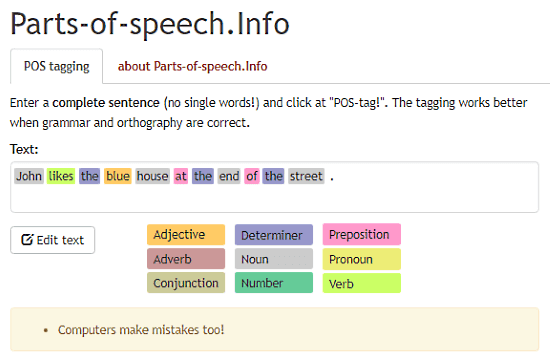
Parts-Of-Speech.info is a simple website designed for online POS tagging. It uses Stanford University Part-Of-Speech-Tagger for the POS tagging. When you paste your text here, it marks the parts of speech in your text. This website can identify the following parts of speech in your text:
- Adjective
- Adverb
- Conjunction
- Determiner
- Noun
- Number
- Preposition
- Pronoun
- Verb
Parts-Of-Speech.info uses a color scheme to mark parts of speech. A color is defined to each POS which it uses to highlight your text. It can easily label POS in a text of up to 500 words.
Give this online POS tagger a try here.
ReTextJS.GitHub.io
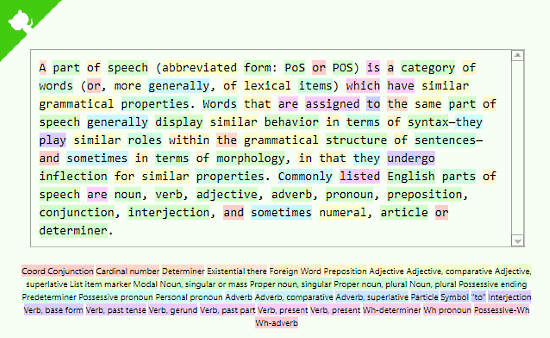
ReTextJS.GitHub.io is an online implementation of a GitHub project ‘ReText‘ developed to mark the parts of speech in a text. This web tool follows a customized POS tagset to address more than 20 different parts of speech. Just paste your text into the box and it will tag the POS for you.
Just like Parts-Of-Speech.info, this online POS tagger uses a color-scheme to mark different parts of speech. There is no maximum word limit mentioned. I tested it for over 5,000 words, which took some time but eventually gave me the results. To read the technical part of this POS tagger, you can visit its GitHub page here.
You can try this online POS tagger here.
CogComp.org
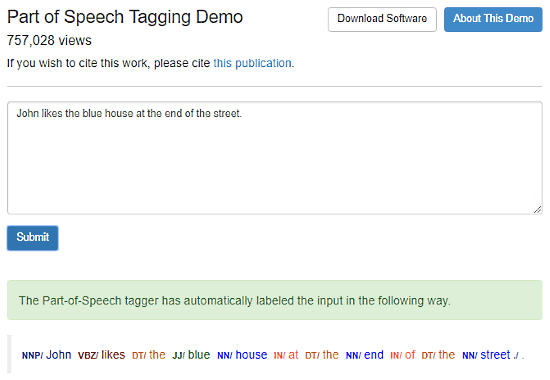
CogComp.org is a website of a research group at the University of Illinois that focuses on the computational foundations of intelligent behavior. They offer a Part of Speech Tagging Demo that labels the POS in a text.
This demo uses their own set of tags which they developed using a computer learning architecture called ‘SNoW‘. It can easily label 47 different parts of speech in a 100 words long text. In the results, it uses short names for POS which you can easily understand by relating to the given ‘POS Key‘ table.
Tag parts of speech in the text with this online POS tagger here.
Text-Processing.com
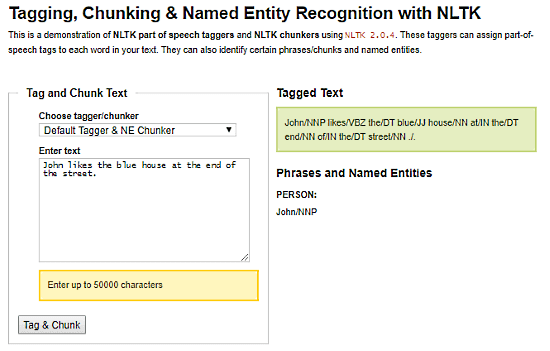
Text-Processing.com offers various Natural Language Processing API and Python NLTK Demos. It also has a ‘Tagging, Chunking & Name Entity Recognition Demo’ which you can use for tagging POS in your text. This demo supports 23 tag and chunk sets for 11 different languages. Along with their own, it supports the following tag-sets for English POS tagging:
- Brown
- NPS chat
- Switchboard
- Timit
- Treebank
- CoNLL2000
Just like CogComp.org, It uses a key-table short form scheme to label the part of speech. You can easily tag parts of speech in a text up to 50,000 characters here.
Try this online POS tagger here.
Stanford.edu
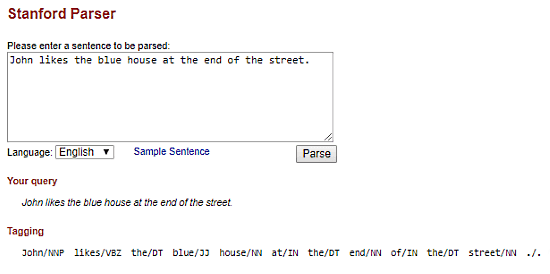
Stanford Parser is another online POS tagger. It also uses a key-table short form scheme to label the parts of speech in your text.
Apart from English, it can tag parts of speech for Arabic, Chinese, French, and Spanish language as well. There is no limitation of text length here. I tested it for over 8,000 words, it took a couple of minutes to process that much text and eventually did give me the results.
Give this online parts of speech tagger a try here.
Wrapping Up:
All these online POS tagger websites are very efficient and easy to use. Selecting one totally depends on users need and preferences. Give them all a try and share your experience in the comments.